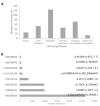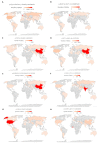Connexin Genes Variants Associated with Non-Syndromic Hearing Impairment: A Systematic Review of the Global Burden
- PMID: 33126609
- PMCID: PMC7693846
- DOI: 10.3390/life10110258
Connexin Genes Variants Associated with Non-Syndromic Hearing Impairment: A Systematic Review of the Global Burden
Abstract
Mutations in connexins are the most common causes of hearing impairment (HI) in many populations. Our aim was to review the global burden of pathogenic and likely pathogenic (PLP) variants in connexin genes associated with HI. We conducted a systematic review of the literature based on targeted inclusion/exclusion criteria of publications from 1997 to 2020. The databases used were PubMed, Scopus, Africa-Wide Information, and Web of Science. The protocol was registered on PROSPERO, the International Prospective Register of Systematic Reviews, with the registration number "CRD42020169697". The data extracted were analyzed using Microsoft Excel and SPSS version 25 (IBM, Armonk, New York, United States). A total of 571 independent studies were retrieved and considered for data extraction with the majority of studies (47.8% (n = 289)) done in Asia. Targeted sequencing was found to be the most common technique used in investigating connexin gene mutations. We identified seven connexin genes that were associated with HI, and GJB2 (520/571 publications) was the most studied among the seven. Excluding PLP in GJB2, GJB6, and GJA1 the other connexin gene variants (thus GJB3, GJB4, GJC3, and GJC1 variants) had conflicting association with HI. Biallelic GJB2 PLP variants were the most common and widespread variants associated with non-syndromic hearing impairment (NSHI) in different global populations but absent in most African populations. The most common GJB2 alleles found to be predominant in specific populations include; p.Gly12ValfsTer2 in Europeans, North Africans, Brazilians, and Americans; p.V37I and p.L79Cfs in Asians; p.W24X in Indians; p.L56Rfs in Americans; and the founder mutation p.R143W in Africans from Ghana, or with putative Ghanaian ancestry. The present review suggests that only GJB2 and GJB3 are recognized and validated HI genes. The findings call for an extensive investigation of the other connexin genes in many populations to elucidate their contributions to HI, in order to improve gene-disease pair curations, globally.
Keywords: GJB2; connexin; gap junction protein; gene variant; systematic review.
Conflict of interest statement
The authors declare no conflict of interest. The funders had no role in the design of the study; in the collection, analyses, or interpretation of data; in the writing of the manuscript; or in the decision to publish the results”.
Figures






References
-
- James M., Kumar P., Ninan P. A study on prevalence and risk factors of hearing impairment among newborns. Int. J. Contemp. Pediatr. 2018;5:304–309. doi: 10.18203/2349-3291.ijcp20180018. - DOI
-
- WHO Prevention of Blindness and Deafness. [(accessed on 30 March 2019)]; Available online: https://www.who.int/pbd/deafness/hearing_impairment_grades/en/
Publication types
Grants and funding
LinkOut - more resources
Full Text Sources
Research Materials
Miscellaneous

